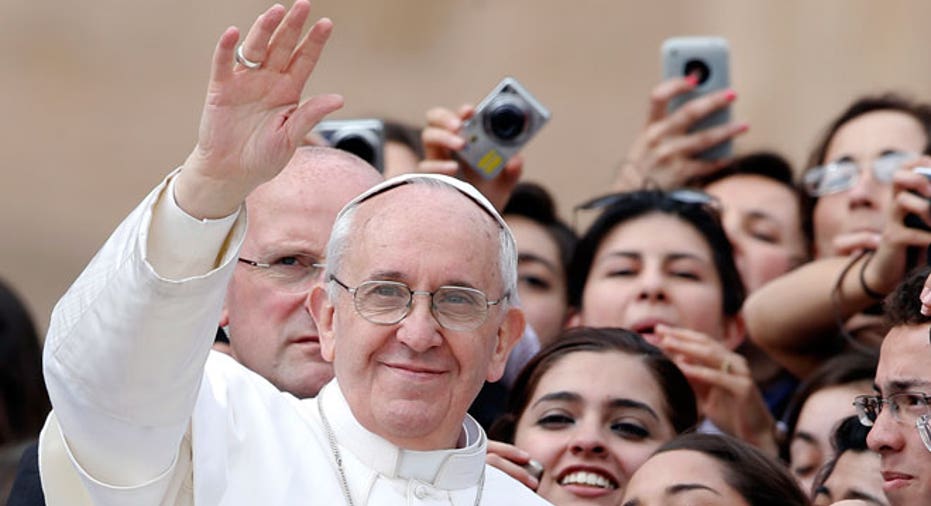Union Leaders Could Learn a Thing or Two from the Pope

Organized labor in the U.S. could use a figure like Pope Francis, someone to re-energize the moribund, unpopular movement and remind people of the original intent of unions – helping working-class Americans.
If anything, the pope has a tougher go of it, attempting to convince millions of increasingly frustrated and skeptical American Catholics to return to a religion badly marred by a long-running sex abuse scandal and the perception of a leadership hierarchy aloof to the needs of its constituents.
Less than a year into his papacy, Francis has struck a popular chord by preaching a message that the church needs to return to its roots, that priests at the local level need to be more attentive to the concerns of their parishes than to the vast bureaucracy within the Vatican.
Profiles of the pope appearing in U.S. media have noted his savvy awareness of the importance of good public relations.
U.S. labor leaders could learn a lot from Francis’ example.
I’ve always been struck by the similarities between the trajectories of the Catholic church and organized labor in the second half of the 20th century. In the 1950s and 1960s, both institutions played integral roles in working-class neighborhoods across the country, one providing emotional and spiritual support, the other fighting for a steady livelihood and a safer workplace.
The Church and Unions Lost Their Way
But both the church and organized labor seem to have lost their way as the century moved into its latter decades, both institutions confusing the needs of their respective leaders with those of their flock.
And the result has been the same: members have left in droves.
As the church enjoys a bit of a renaissance under the new leadership of Pope Francis, the American labor movement has arguably hit a nadir, coming off a devastating loss by the United Auto Workers at a Volkswagen plant in Chattanooga last weekend.
But the defeat merely emphasized organized labor’s rapidly declining influence among those who once depended on unions to guarantee them a living wage and adequate benefits.
The numbers are familiar to anyone paying attention to U.S. labor trends in recent decades: union membership has declined to 11.3% of all American workers in 2013, down from about 20% in 1983. That figure falls to a paltry 6.7% in the private sector, while union membership in the public sector stands at 35.3%.
The latter category has come under considerable fire in recent years from taxpayers angry over generous pensions and benefits for public employees negotiated and approved by politicians who cozy up to union leaders in an effort to ensure re-election. This dynamic is especially true at the local level where a meager 100 votes in a city council election can make all the difference.
This is how parks and recreation directors and public works superintendents, not to mention fire and police chiefs, across the country are retiring with six-figure pensions and full healthcare benefits for life even as the towns they worked for are going broke.
Now local and state governments are shedding jobs because taxpayers can no longer flip the bill to cover payroll costs for existing employees as well as the overly-generous pensions and benefits of retired employees.
A Change In Message
Indeed, since the recession officially ended in June 2009, the private sector has added 2.8 million jobs, according to a recent report from the Economic Policy Institute, a pro-organized labor research center in Washington, D.C. Meanwhile, the public sector – municipal, state and federal governments – has lost 584,000 jobs during the same period, the EPI reported.
The dynamic is reminiscent of what happened to workers at Detroit’s Big Three automakers. Years of ostensible union wins in contract negotiations with the car makers allowed deeply entrenched union leaders to lose sight of the long-term well-being of their members, many of whom lost their jobs when General Motors and Chrysler went bankrupt in 2009.
Meanwhile, foreign car makers – such as Volkswagen – saw an opening created by the Detroit car makers’ paralysis and built factories in the predominantly anti-union South, taking advantage of cheaper labor costs to make more affordable cars.
The image of the U.S. labor boss has shifted quite a bit in recent years, but not necessarily for the better. Instead of the old Jimmy Hoffa archetype – rough and tumble, cigar in hand and most likely corrupt – the new bosses are perhaps best represented by such high-profile leaders as Randi Weingarten, the fiery head of the influential American Federation of Teachers. This new breed is widely viewed as stubborn bordering on unyielding and stuck in a bygone era when unions enjoyed much broader support and private companies as well as state and local coffers were more flush.
But times have changed and many American workers – see Volkswagen workers in Chattanooga – clearly no longer feel the need for union protection.
Pope Francis, facing a similar exodus, has shifted the church’s message in an effort to bring home his straying flock. So far the pope’s efforts seem to be working. Union officials should consider a similar strategy.